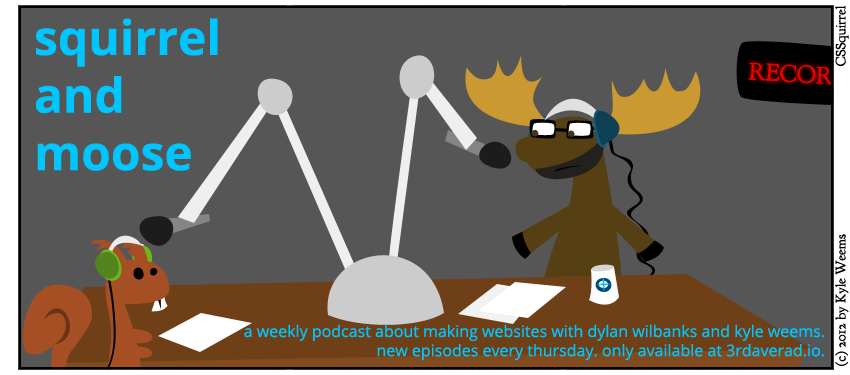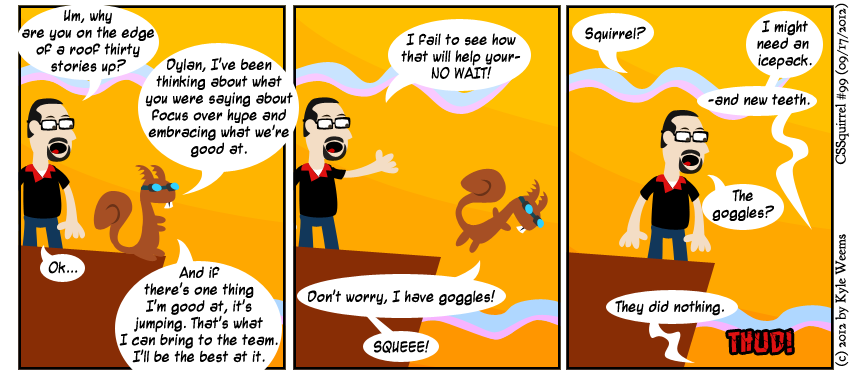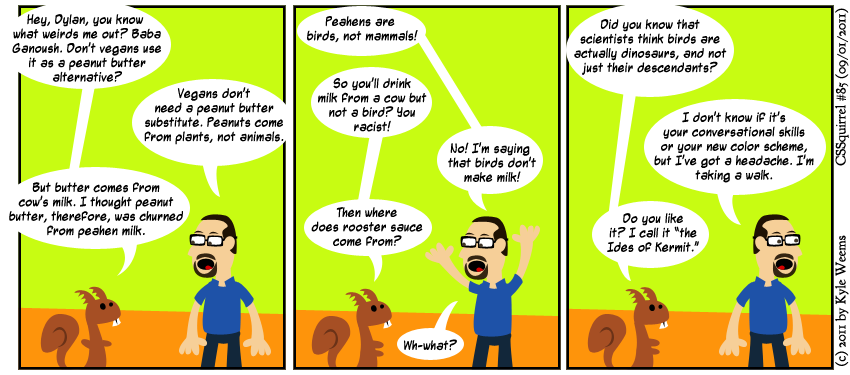In a way I should be grateful to Ian “Hixie” Hickson for being an egotistical tyrant. Without his inability to acknowledge that a consensus-driven, well-crafted and usable solution built by a group of well-meaning, hard-working people could actually somehow be better than his own personal opinion, he’s pulled me out of my long-hiatus and back to to the drawing board.
Today’s comic is in fact three comics. No single idea could encompass everything. In all three Hixie gets top billing as the editor-for-life of HTML’s “living spec”. The first comic features Naepalm, chinchilla alter ego of fellow Mindflier Janae Wiedmaier. The second one includes the irreplaceable Justin McDowell. Lastly we see Matt May, Dylan Wilbanks and Ethan Marcotte joining forces with the Squirrel in a bid to take down the HTML king.
(Today’s comics as per usual aren’t meant to imply that the people represented therein endorse my views. I’m saying it outright today because I’m feeling particularly vitriolic and don’t want my words to reflect on them.)
The Situation
For those of you just tuning in, today’s outrage focuses around Hixie’s decision to adopt a problematic, late-arriving, Apple-proposed attribute of the <img> tag into the HTML standard as the solution to the adaptive images issue. In the process he again reinforces his inability to heed the creed of HTML’s priority of constituencies (end users over authors over implementers) while also tossing away the hard work of a community group of developers that built a very functional, very usable solution to that problem in the form of the <picture> element.
If you’d like a summary, you can check out the aptly titled WTFWG by Tim Kadlec, or take a look at Zeldman’s take on the situation over here, which links into an A List Apart article by Mat Marquis on the topic.
I wish this was a new situation. Or that it was surprising. Or that I didn’t feel like I was repeating myself each time I mention Hixie in blog or comic form. The fact is that as the Editor of HTML, Ian keeps doing this. And we keep letting him.
The Puppet
At one point I attributed this issue solely to his gigantic ego and clearly overwhelming case of not invented here syndrome. Now I’m frankly convinced that although these qualities contribute to the problem, the real issue is that he’s the puppet of the browser vendors, namely the three most involved in WHATWG: Apple, Opera, and Google. Although the priority of constituencies dictates that implementers (aka, browser vendors) should be lower priority than developers (who are in turn answerable to end users), it seems that without fail Hixie will bow to the vendors before considering any work on the part of developers at a solution, no matter how reasonable, well-built and documented that solution is.
That’s not a kind accusation, that a man is a puppet. But clearly every attempt to work with the WHATWG has always resulted in developers being treated as second-class citizens to the browser makers. And let’s make it clear: this is our job. We make websites for a living, and the tom-foolery that Ian is engaged in is directly impacting our present and future workflow. We work on making websites every damn day. We know what works for us, and what doesn’t.
And he doesn’t care in the slightest.
“Work With Us”
At this point, Hixie and his backers are relying on the same smoke and mirrors to distract people. Present use cases. Keep engaged with the WHATWG and let them know your technical objections. Get involved in their IRC. But the fact is we as developers have done this over and over and over. Yet at the end of the day, regardless of the hard work put in and all the proof jammed into the pudding, it all amounts to naught. Hixie spends twelve seconds coming up with his own solution or takes what the browser makers gives him and uses that instead.
It happened with metadata. It happened with the <time> element. It’s happening now with responsive images.
The fact is that Ian doesn’t give a shit.
He’s going to do it his way, or failing that he will do what Google and the other browser makers in the WHATWG tell him to do. He’s not going to look at what the developers have built and give that solution a thumbs-up. As John Foliot said: “Dev community, if you continue to author to the WHAT WG doc, you lend your tacit support to heir hixie. Look where that gets you.”
Enough Is Enough
Being part of their process is being part of the problem. I’ve never seen things resolved by following the WHATWG’s “process”, as it amounts to little more than distracting developers while he goes off and implements a less functional, more complex solution to the problem.
Don’t deal with Hixie. Don’t deal with the WHATWG. Directly object to the browser vendors. “Occupy” HTML by making use of the consensus-built techniques that already have functional polyfills. Do what makes sense, and what works for you.Sooner or later, the browser vendors will be tired of the grief sent their way and tell Hixie to roll over.
<time> wasn’t fixed because we followed the WHATWG’s process.
I’m going to say it: I don’t believe that WHATWG is part of the solution anymore. As I’ve been told by others, democracy isn’t always the best approach. Sure, ok. But so far when it comes to the community-build, consensus-driven approach and Hixie’s brain, the community’s solution has proven more effective more often.
I’m going with the community, not the puppet.



